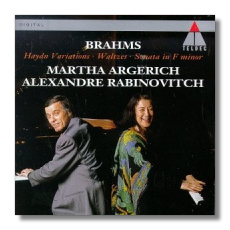
The Internet's Premier Classical Music Source
Related Links
- Brahms Reviews
- Latest Reviews
- More Reviews
-
By Composer
-
Collections
DVD & Blu-ray
Books
Concert Reviews
Articles/Interviews
Software
Audio
Search Amazon
Recommended Links
Site News
 CD Review
CD Review
Johannes Brahms

Music for Two Pianos
- Variations on a Theme by Joseph Haydn, Op. 56b
- Sonata for Two Pianos in F minor, Op. 34b
- Waltzes, Op. 39
Martha Argerich & Alexandre Rabinovitch, pianos
Teldec 4509-92257-2 64:09
Summary for the Busy Executive: Suave, but not especially insightful.
Brahms, a musician with a head for business, died a wealthy man. He made some of his money on the Viennese stock exchange, but when it came to marketing his own compositions, he was a master. Unlike Beethoven, who merely sold the "exclusive" rights to the same composition six or seven times, Brahms cannily made different arrangements of the same works. Ein deutsches Requiem, for example, exists in a version for two pianos, soloists, and chorus. Both the third and fourth symphonies were published first in arrangements for two pianos, before their premières. Not only did this stratagem, in the age before recorded music, make the work available to those who didn't happen to live in cities where the symphonies appeared on concert programs, it also allowed people to gain an intimacy with the score before the official première. The liner notes point out that two pianos itself is a fairly "elitist" combination, since not many middle-class households owned two pianos. For this reason, four-handed piano works (two players at one keyboard) were far more popular, and, of course, Brahms wrote those works as well. However, the writer fails to take into account how households make music. A lot of two-piano music gets played on a single piano. Players simply work out the choreography.
Brahms in fact wrote the two-piano version of the Haydn-Variationen before the orchestral one, although he always intended the work eventually for the orchestra. The Sonata for 2 Pianos, however, had a more complex story behind it. Brahms began it as a string quintet – this version now lost. He recast it as the Sonata but remained dissatisfied. He then turned it into the f-minor Piano Quintet. The opus 39 Waltzes began as a work for solo piano. Brahms also provided an "easy" edition, also published, and mentioned to Simrock that he had arranged five of the sixteen waltzes for two pianos. Simrock declined to publish these for about thirty years but, sensing more money to be made from a by-now classic name, relented a year after Brahms had died.
The Haydn-Variationen, in my opinion, succeeds best of these works. The Sonata is a bit heavy in the lyrical sections and monochromatic. But I might think this way because I can't erase the memory of the Piano Quintet, where the strings provide color contrast as well as greater cantabile. The Waltzes seem perfect examples of the "normal" two-piano genre, ideally suited to music-making in the home. The Haydn-Variationen, of course, achieve far more, one of the greatest variation sets since Beethoven.
The performances are a mixed bag. Argerich takes the primo piano for the variations and the secundo for everything else. The variations sound suave, rather than deep, with a beautiful "star" sheen. Yet it's probably not the most penetrating interpretation you have ever heard. The passacaglia finale, essentially a variation form with a set of variations, is all surface – a beautiful surface, admittedly, but without the cumulative power that, say, Klemperer manages to achieve. The sonata and the waltzes are more percussive, rougher, which I put down to Rabinovitch taking the lead. The sonata in particular comes across as hammering and unrelenting, but in some part this comes from the nature of Brahms' writing. One of these days, I'm going to have to do a score-by-score comparison of the sonata and the piano quintet versions to check for essential differences between them. Still, I expect Rabinovitch and Argerich to adjust. I would have preferred a performance which sang more. This goes double for the waltzes. Rabinovitch plays way too hyper, even affectedly, in the first. The articulation – staccato sec – seems more like a feat, rather than music-making. The second and third waltzes, on the other hand, are just plain lovely, with a beautifully-managed rubato at the end of the third. The fourth – a furious allegro reminiscent of some of the Hungarian Dances – is plenty furious, but plenty lightweight as well. I've heard more power from solo piano performances. My favorite waltz of any of the versions is the one in A Flat Major, which closes this set – a gorgeous melody with a radiant harmonic progression in the second strain. Rabinovitch and Argerich disappoint big-time with a rather kitschy account where they pull tempi like taffy. I prefer Lipatti, Fleisher, and Klien.
The recorded sound is Teldec's usual faultless.
Copyright © 2002, Steve Schwartz


















